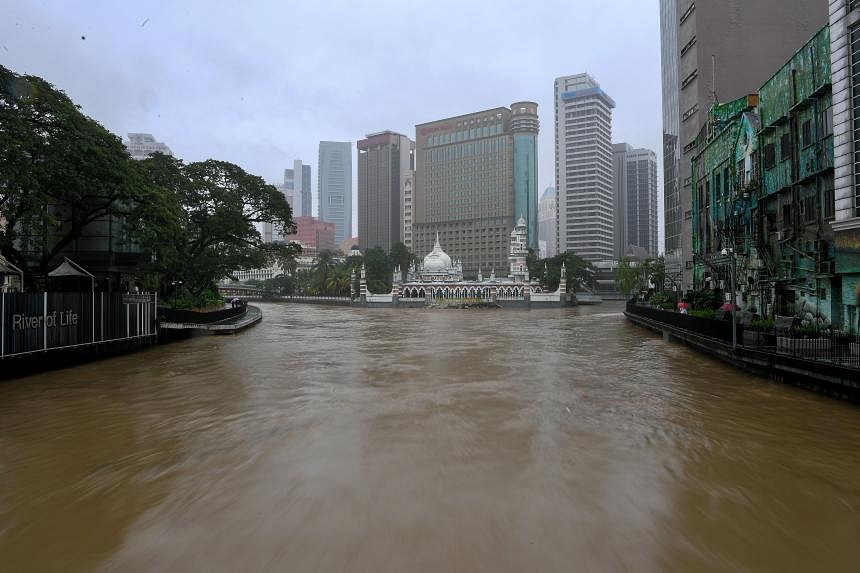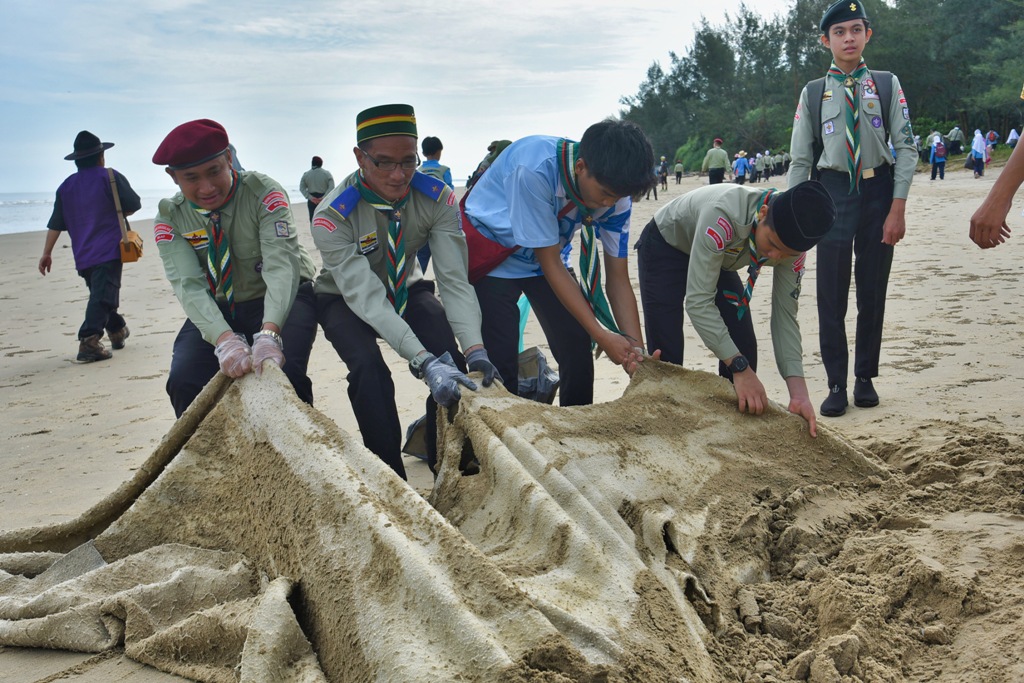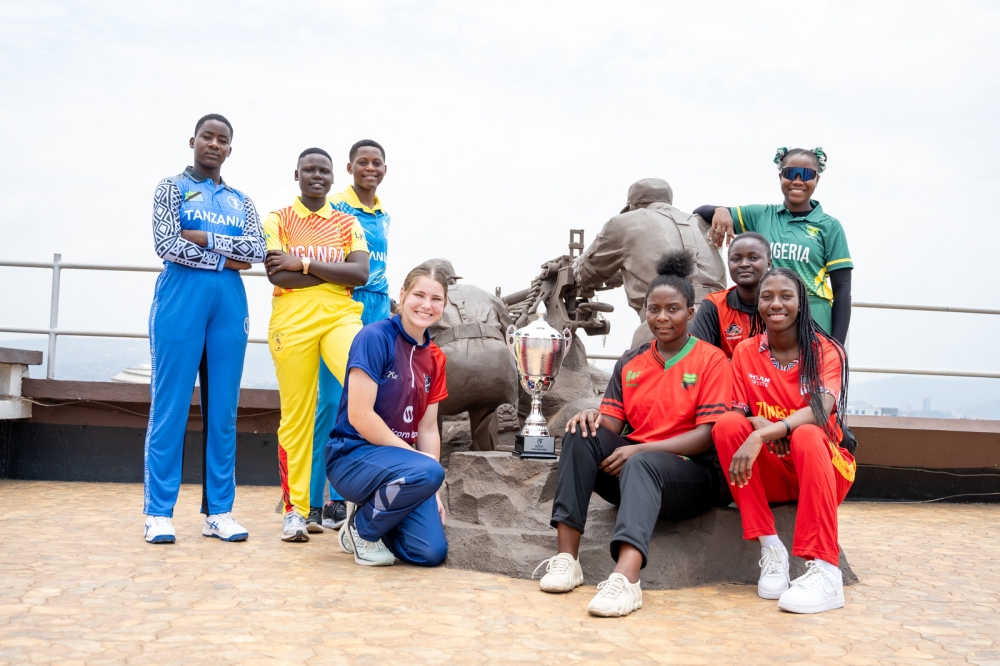The estuaries of Gombak River (left) and Klang River (right) in an old section of Malaysia's capital city Kuala Lumpur. KUALA LUMPUR - One of the oldest mosques in Malaysia’s capital city and the river banks around it have undergone a radical makeover in recent years to beautify the heritage heart of Kuala Lumpur’s old downtown. In the evenings, the riverbanks around Masjid Jamek are often covered in theatrical mist – hissing out from rows of pipes – and the river water is lit in a stunning shade of blue.
The riverbanks beside another prominent landmark nearby, the Sultan Abdul Samad Building that used to house the offices of the British colonial administration, have also been rejuvenated. The mosque sits at the meeting point of two major rivers, Gombak and Klang, and the area is reputedly where Kuala Lumpur – a ‘muddy estuary’ in Malay – was born. The rivers are among eight in the federal territory and Selangor that form the core of the ambitious River of Life (RoL) project that was initiated in 2011 to revitalise the waterways, with the aim of matching the success of Seoul’s Cheonggyecheon’s stream restoration project.

But while visible – and impressive – improvements could be seen, such as around the Masjid Jamek area, other areas along the riverbanks appear untouched though the project was launched 13 years ago. “It’s not like in Melaka, where the river is a tourist spot. The River of Life project has been delayed for so long,” said a shopkeeper by the Central Market which is located along the Klang River.
“They need to make it clean, and have activities such as boat rides to attract tourists,” he said, declining to be named for privacy reasons. “It’s disappointing to see how little has changed in the years since I first came here,” Ms Julie-Ann Sherlock, a travel writer from Ireland who first visited Kuala Lumpur in 2017 and spends a lot of time in the country, told The Straits Times. One of the successes of the multi-billion-ringgit River of Life project is the transformation of one of the most iconic parts of Kuala Lumpur near Masjid Jamek, the oldest mosque in the city, at the convergence point of the Klang River and the Gombak River.
ST PHOTO: HAZLIN HASSAN Launching the project in 2011, then-premier Najib Razak said: “I visited the Cheonggyecheon River project in Seoul. The project is the best example of the transformation of a polluted and dirty river into a model river complete with beautiful walkways, bridges and fountains.” The RoL was designed to clean and beautify a 110km stretch of the Malaysian capital’s rivers and spur economic investment in the surrounding areas.
Unfortunately, despite RM3.9 billion (S$1.2 billion) having been spent, the project has faced over eight years of delays.
And it will not meet its deadline this year to achieve its objectives, said a damning report contained in the 2024 Auditor-General’s Report released on July 4. Najib had defended the project in a Facebook post on July 16, saying the RoL was 80 per cent completed in 2018. But between 2018 and 2024, it only progressed by one per cent.
Najib and his coalition was voted out of power in 2018. The Auditor-General outlined a laundry list of failed targets. “This includes RoL’s objectives to improve the river water quality to Class IIB (suitable for recreational use with body contact), which is hard to achieve, due to weakness in planning, implementation, low level of asset operations as well as low level of river care awareness,” said the Auditor-General’s report.
Another notable failure involved the construction of collapsible weir units – small dams designed to raise the water level for boating activities yet allowing river water to flow during floods – costing RM33.37 million. One unit was non-operational, and the other incomplete.
The report also found that the absence of a comprehensive business model led to inadequate maintenance and underutilisation of RoL assets. The report stated that “147 river cleaning assets were found non-operational due to damage, (being) demolished, or unusable”. Furthermore, the project suffered from weaknesses in governance, including planning, monitoring, and execution.
Federal Territories Minister Dr Zaliha Mustafa, who in 2023 inherited the project from past governments, said in Parliament on July 10 that RM3.3 billion was allocated for river clean-up and RM1.06 billion for beautification.
As of June 30, she said that 130 out of 160 projects were completed, representing 81 per cent progress. That’s just one percentage point higher than Najib’s 80 per cent-completion announced in 2018. The RoL project was meant to transform the Klang and Gombak rivers into clean waterways, by addressing pollution and conducting flood mitigation.
But ongoing pollution from industrial and residential sources have continued to undermine these goals. Despite RM3.9 billion of government expenditure having been poured into the River of Life project, garbage and murky water can be seen in the Klang River near Central Market in Kuala Lumpur.
ST PHOTO: HAZLIN HASSAN Community leader Mr Kennedy Michael said he discovered just several weeks ago that the subsidiary of a public-listed company was discharging human faeces into the river from its construction site. He is the founder of community-based river ecosystem restoration group, Alliance of River Three, that is working on restoring a five-kilometre section of the Klang River by planting trees to regenerate the ecosystem. As of now, Class I water quality, the highest quality, has been achieved for a one-kilometre stretch.
The group hopes the river would one day achieve Class I water quality over the five-kilometre span. That is unlikely to be achieved anytime soon, at least for the rest of the river. Just a few kilometres up the banks of Klang River, near the foot of Bukit Antarabangsa township, a row of some 20 shops including restaurants and car workshops have for years been using the waterway as a dumping ground.
University lecturer and former Democratic Action Party (DAP) deputy minister, Professor Ong Kian Ming who has taken a personal interest in the project, issued a bold challenge for RoL officials. They should emulate Paris mayor Anne Hidalgo’s approach of swimming in the Seine during preparations for the 2024 Olympics, to prove that the project is bearing results, he said in a statement on July 18. The river oscillates between Class II and Class III, depending on the weather, day of the week, and other factors, said Prof Ong.
“The river smells less now compared to 2015. The water cleanliness matters because at IIB and above, the water is fit for recreational activities including swimming and kayaking. And Class III and below, going into the river is unsafe for humans, he told ST.
“It’s a huge amount of money over 14 years – enough to build a new hospital or upgrade a few airports,” he added. The River of Life project was designed to clean and beautify a 110km stretch of the Malaysian capital’s rivers and spur economic investment in the surrounding areas. ST PHOTO: HAZLIN HASSAN Perhaps not everything is bleak.
Photography artist Jeffrey Lim, who was part of a kayak reconnaissance along the Klang River by Prof Ong in 2015, highlighted some successes, such as improvements in sewage issues. “Black water sewage was one of the main issues, with raw sewage flowing into rivers. I have seen an improvement in this area since then,” he said.
“It was a colossal project. An idealistic one, but nonetheless needed. It was too fast, too ambitious, too costly, for only two rivers.
” Dr Zaliha has pledged to continue the project, emphasising its ability to transform Kuala Lumpur. “The River of Life project needs a new lease of life. It has the potential to be an iconic project that will change the landscape of downtown Kuala Lumpur and beyond,” said Prof Ong.
Join ST's Telegram channel and get the latest breaking news delivered to you. Read 3 articles and stand to win rewards Spin the wheel now.



















